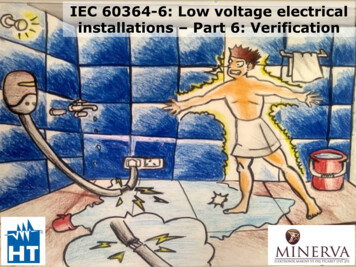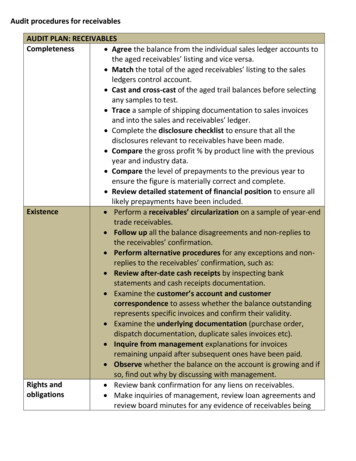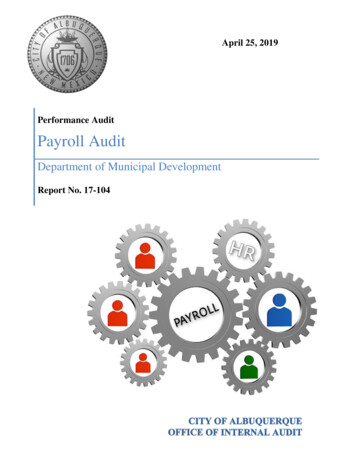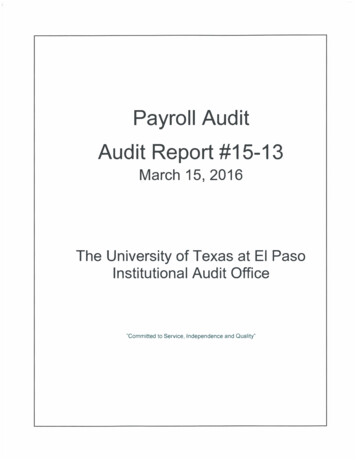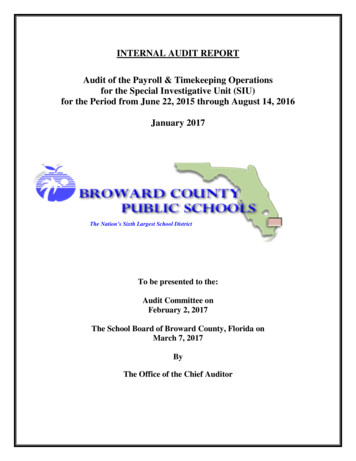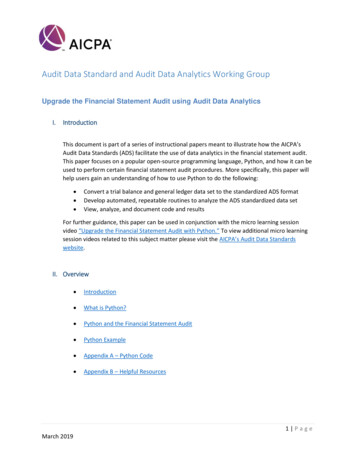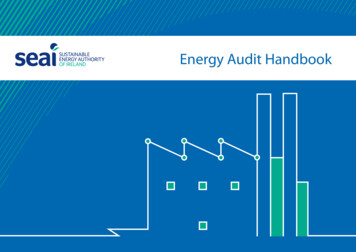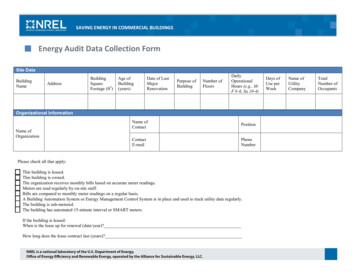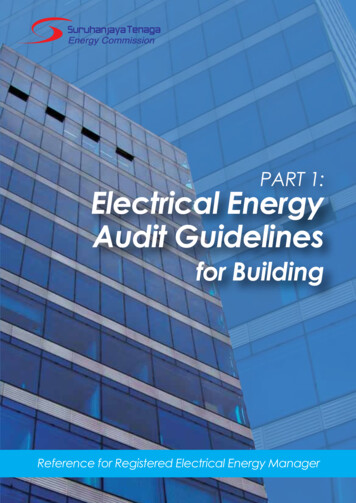
Transcription
PART 1:Electrical EnergyAudit Guidelinesfor BuildingReference for Registered Electrical Energy Manager
All rights reserved. Reproduction of all or any part of this publication viaelectronic, mechanical, recording or other medium is strictly prohibitedwithout written consent from the Energy Commission.Published by:SURUHANJAYA TENAGA (ENERGY COMMISSION)No. 12, Jalan Tun Hussein, Precinct 2, 62100 Putrajaya, MalaysiaT : 03 8870 8500F : 03 8888 86371-800-2222-78 (ST)www.st.gov.myISBN 978-967-13778-6-4ST Publication No. : ST(P) 16/09/2016PRINTED IN MALAYSIA
Contents1.Introduction21.1.Objectives22.Energy Audit Definitions22.1.Types of Energy Audits32.1.1.Walk-Through/Preliminary Energy Audit32.1.2.Detailed Energy Audit33.Detail Energy Audit Process53.1.Data Collection53.1.1.Desktop Data Collection53.1.2.Field Data Collection63.1.3.Cross Checking of Load Demand Data73.2.End-Use Load Apportioning83.3.Analysis and Identification of Energy Conservation9Measures (ECMs)3.4.Reporting10AppendicesAppendix 1 – Reporting Descriptions11Appendix 2 – Sample Forms & Tables15Appendix 3 – Sample Chart & Graph23Appendix 4 – Example of ECMs27Appendix 5 – Recommended Guidelines31
1. IntroductionEnergy plays a key role in the development and growth of the economy.The Malaysian government has put special emphasis to ensuringadequate, reliable, secure and cost effective supplies and to utilizingenergy resources efficiently while minimizing the negative impacts on theenvironment. To ensure that there is sustainability of energy in the future,energy audit activities are necessary to determine suitable steps to beundertaken to use energy efficiently. An energy audit is an examinationof the energy consumption of the equipment or system to ensurethat energy is being used efficiently. This is one of the responsibilitiesof the Registered Electrical Energy Manager (REEM). This is a guidelinefor Registered Electrical Energy Manager (REEM) during their energyaudit exercise. REEM should not be bound with this guideline but theyhave to establish their own justification in order to meet the facilitiesrequirement according to the types and purposes such as offices, hotels,shopping complexes, hospital, college/universities and etc.1.1. Objectivesi)To set minimum standards for undertaking detailed energy audit.ii) To guide REEM, asset owner and/or operator to identify EnergyConservation Measures (ECMs) in buildings.2. Energy Audit DefinitionsThere are several definitions of an energy audit. Some guidebooksdefine energy audit as a systematic, documented verification process ofobjectively obtaining and evaluating energy audit evidence, in conformancewith energy audit criteria and followed by communication of results tothe client1 (CIPEC 2002). In the Indian Energy Conservation Act 20012(BEE 2008), an energy audit is defined as the verification, monitoring andanalysis of the use of energy and submission of technical report containingrecommendations for improving energy efficiency with cost benefitanalysis and an action plan to reduce energy consumption. Howeverin Malaysia, it was defined as a process which is very much central forconducting an energy management project or in general an energy audit1. Canadian Industry Program for Energy Conservation (CIPEC), Canada2. Energy Management and Audit, Bureau of Energy Efficiency (BEE), India3. Guidelines for conducting Energy Audit Commercial Buildings, Malaysia2
is a study conducted to identify where, when and how much energy isbeing used in the business and how to reduce the cost of energy forthe business3. Even though there are several definitions, the objectiveor goal is the same which is to reduce the energy consumption withoutcompromising comfort and quality of the building. This guideline is meantfor REEM who have basic understanding on energy audits, for them toconform to the requirements of the Efficient Management of ElectricalEnergy Regulations 2008 (EMEER 2008).2.1. Types of Energy AuditsThere are basically two types of energy audits. These are:i)Walk-through/preliminary energy auditii) Detailed audit2.1.1. Walk-through/preliminary Energy AuditWalk-through audit is a process used to establish an overall picture ofthe potential of energy savings through visual inspection of the premiseincluding air conditioning system, lighting, metering, building automation,building maintenance and other factors affecting energy consumption ofthe building. References to the records of equipment ratings, technicalcatalogues, operation and maintenance (O&M) manuals that are readilyavailable will be very helpful to quickly determine whether equipmentor systems are operating efficiently. Calculation, usually simple in nature,should be done to quantify the savings achievable from implementationof the identified ECMs.The walk-through/preliminary energy audit usually is carried out in oneor two days by either REEM alone or with a team, depending on thesize, complexity of the building and the scope of audit. Usually, simpleinstruments such as a clamp amp meter, thermometer, hygrometer(humidity meter) and lux meter will serve the purpose.2.1.2. Detailed Energy AuditThe detailed energy audit involves in-depth investigations into how theenergy is currently being consumed, current performance of the existingsystems and identification of various potential ECMs. It also gives theestimated cost and simple payback periods for all recommended ECMs.3
The detailed energy audit involves the following four (4) main processes:i)Data collectionii) End-use load apportioningiii) Identification of ECMsiv) Reporting and presentationFigure 1.0 shows the process flow of a detailed energy audit.Figure 1.0: Flow chart of a detailedenergy audit processData CollectionDesktop Data CollectionField Data CollectionCross Checking of Load Demand DataEnd-use Load ApportioningAnalysis and Identification ofEnergy Conservation MeasuresReporting4
3. Detail Energy Audit Process3.1. Data CollectionOne of the key tasks in Energy Auditing is the collection of all energyrelated data required by the REEM to apportion the total facility energyconsumption into various energy end-uses. The collected data is then usedto build a reliable picture of where and how much energy is being consumedand the cost of energy being used at the building. Data collection is oneof the most laborious tasks in Energy Auditing and inability to collect therequired data will lead to less reliable Energy Audit results.One of the difficulties faced by the REEM in order to establish the building’smajor end-use demands (air-conditioning, lighting and general equipment) isthe limited or lack of building metering equipment. To be able to estimatereliably the major building’s end-use demand, it is recommended that theREEM uses the following three steps to identify the building end-use demand:i)Desktop data collectionii) Field data collectioniii) Cross checking of load demand dataThe process of carrying out these three steps of data collection isexplained in the following paragraphs:3.1.1. Desktop Data CollectionThe purpose of desktop data collection is to minimize the field energy relateddata collection by using all available facility data. It would be advisable duringthe initial process to collect preliminary building energy related data usinga Building Detailed Audit form shown in Appendix 2. This form allows theREEM to understand the nature of the audited building and areas to focuson during the auditing. The data collection through the form can be usedto estimate the time and manpower required for the field data collectionactivity later.5
To minimize the time and manpower for the field data collection, the REEMshould try to gather energy related data as much as possible using availableresources such as:i)Architectural drawings (as built drawing)ii) M&E drawings Lighting circuit drawings (as built drawing) Air conditioning system drawing and design manual(as built drawing) Single line power supply schematic drawings (as built drawing)iii) Electrical energy bill historical data (for at least one year)iv) Load control systems such as timers, building automation system if anyand others (as built drawing)The REEM will use all desktop available energy related data to estimate thecurrent building major energy end-uses. Appendix 2 shows a number offorms which can be used to identify various energy use data including lighting,air conditioning, general equipment and area function which has effect on thebuilding energy consumption.The desktop data gathering should be considered as a first step of datacollection, which will be complemented and verified during the Field DataCollection process.3.1.2. Field Data CollectionThe field data collection is a critical step for:i.Complementing the missing data, which the REEM could not findduring the Desktop Data Collection process.ii.Verifying the accuracy of Desktop Data.iii. Understanding closely the building operations, energy wastages andbuilding maintenance status.iv. Carrying out the necessary field measurements required to establishmain incoming load profile, major energy end-uses such as HVAC,lighting and others. Establishing actual building load apportioning.v.The field data forms shown in Appendix 2 can be used to facilitatethe field data collection.The field data forms shown in Appendix 2 can be used to facilitate the field data collection.6
Table of Measurement ToolsNo. Measurement ToolsParameters to be Measured1.AnemometerVelocity of air in ducts, windows and otheropenings for estimating the amount of airsupply2.Hygrometer (humidity meter)Outside and inside air humidity3.ThermometerOutdoor and indoor dry airtemperature4.Lux meterLight intensity of lit areas5.Clamp on amp meterAmperes of various equipment and supplycables and feeders6.kW (and kVA where applicable)data logger7.CO, CO2 meterkW, kVAR, PF, time and other data relevant tobuilding and main end-uses power suppliesCarbon monoxide, Carbon dioxideconcentration (in ppm)SAFETY PRECAUTIONSAll audit activities have to comply with the Electricity Regulations 1994of Electricity Act 1990 and other safety related acts and regulations3.1.3. Cross Checking of Load Demand DataThe accuracy of estimated end-use energy consumption will affect theaccuracy of estimated energy savings of various building ECMs. Therefore,for reliable estimate of the building and end-use energy consumption, it isrecommended to use the following approach:i.Use the field data collected to estimate the building’s total and end-useenergy consumptions. Due to a number of assumptions used in thismethod, in particular the equipment loading and time usage factors, theaccuracy in estimating the building total end-use energy consumptionmay vary depending on the loads measured. For instance, due to thepredictable nature of lighting load, this method allows reliabledetermination of the building lighting load.7
ii.Use appropriate data loggers to record the building and end-use loadcycles. For example, it is recommended to record typical daily loadprofiles of main incoming for seven (7) days, one (1) to seven (7) daysfor HVAC system and one (1) hour to one (1) day for other equipments.A sample of building load data log is shown in Appendix 3.The logged data can be used to verify the accuracy of the estimatedbuilding total and end-use energy consumption generated by thedesktop data collection. If there is a large deviation between the end-useloads estimated by desktop data collection and the end use loadsestimated by field data collection, the REEM should alter the assumptions(equipment loading and time usage factors) applied in estimating thebuilding equipment loads used in the desktop data collection to reducethese deviations to an acceptable range. REEM should take into accountother factors such as seasonal variations and occupancy changes duringthe year that may impact on overall energy consumption.TIPSThe REEM should use the building monthly billing historical data to verify theaccuracy of the logged typical daily energy consumption and in estimating thebuilding monthly total and end-use energy consumptions.In addition, if the building has tenants supplied and metered separately, and notcovered in the energy audit, than the REEM must ensure that the tenant energyconsumption are taken into account when the building total and end-use energyconsumption are calculated.“Calculating is Better Than Estimating ButMeasuring is Better Than Calculating”3.2. End-use Load ApportioningThe REEM can use the above suggested three steps in energy audit datacollections to apportion the total building load into its major end-use loads.The chart in Appendix 3 shows a sample of load apportioning of a building.8
3.3. Analysis and Identification of Energy Conservation Measures (ECMs)The effectiveness of an energy audit is related to the understanding in depthof the nature and operations of the audited building by the REEM. Knowingthe acceptable level of comfort and tolerance for lighting, temperature andhumidity level by employees are essential to come up with effective andacceptable ECMs.The ECMs can be classified into the following categories:CategoriesDescriptionNo/low cost measuresInvolves practically no/low cost investment andwithout any disruption to building operations,normally involving general housekeeping measuresMedium cost measuresInvolves medium cost investments with someminor disruption to building operationHigh cost measuresInvolves relatively high capital cost investmentswith much disruption to building operationTypical sample of ECMs activities that REEM can start with are listed out inAppendix 4. However REEM should not be bound with this sample only buthave to expand the ECMs according to the findings during the energy auditactivity to suit with the building requirement.TERMS USEDECMs are also known as Energy Management Opportunities (EMO) /Energy Saving Measures (ESMs) / Energy Conservation Opportunities (ECO)9 pa
Guidelines for conducting Energy Audit Commercial Buildings, Malaysia. 3 is a study conducted to identify where, when and how much energy is being used in the business and how to reduce the cost of energy for the business3. Even though there are several definitions, the objective or goal is the same which is to reduce the energy consumption without compromising comfort and quality of the .

